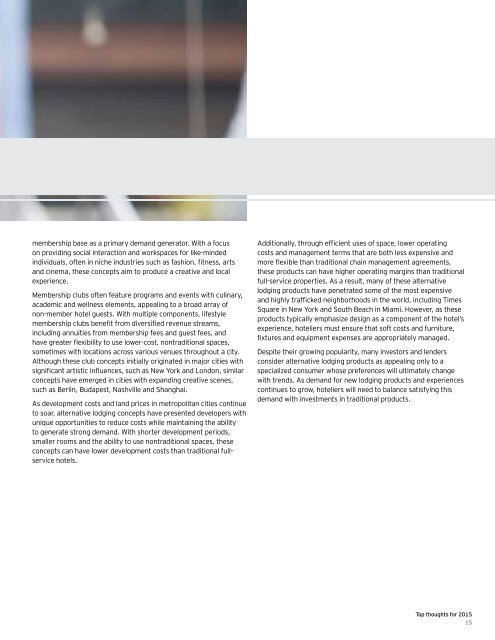Lifestyle lodging productsOver the past several years,the millennial generation hasincreasingly impacted the lodgingindustry, calling into questionproducts and offerings that have fordecades been industry mainstays.Today’s emerging traveler,millennials and millennial-mindedtravelers, is more cost-consciousand experience-focused thanever before, whether traveling forbusiness or leisure. To meet thesechanging demand preferences,hoteliers are seeking innovativealternatives to traditional lodgingproducts. Several of these productsinitially emerged in Europe andAsia, as highly fragmented markets,less stringent lodging standardsand cultural preferences fosteredinnovation in lodging concepts.Now, in the US, these concepts arebecoming increasingly attractive tohoteliers and investors seeking tocapitalize on this changing demandbase while increasing investmentreturns.Historically, the European alternativelodging industry has largely catered tostudents and backpackers, offering no-frillsaccommodations and communal spaces thatprovided cost savings and enhanced socialatmospheres. As these new products andexperiences began to evolve over the lastseveral years, affordability and a focus onsocial experiences were maintained.Substantially aligned with the desires ofmillennials and millennial-minded travelers,these low-cost, amenity-rich hostel, lifestylebudget hotel and hostel/hotel combinationconcepts are now becoming viable inmajor US and Asian markets, such as NewYork, Los Angeles, Miami, Singapore andTokyo, where traditional hotel rates areprohibitively expensive, as well as marketssuch as Detroit, New Orleans, Nashvilleand Portland, where unique atmospheres,architecture and cultural elements drawgreater demand. With a focus on limitedservice with added conveniences, theseproducts are able to decrease costs byremoving unnecessary and high-costelements, such as large guestrooms with fullfurniture sets, full-service restaurants, roomservice and daily housekeeping. It replacedthem with more practical alternatives,such as smaller rooms, grab-and-go foodand beverage outlets, daily housekeepingto hotel rooms but not to hostel rooms,free bicycles, free Wi-Fi and iPad usageand pay-as-you-go amenities such as airconditioning, towels, toiletries and highqualityin-room coffee machines.These new products and concepts oftenemphasize common areas, lounges and barsas the focal point of the property and inviteguests to spend more time congregatingin revenue-generating areas of the hotel,in turn maximizing revenue per occupiedroom (RevPOR) spent. Communal spacesare often intended to be inviting to guestsby seamlessly blending with the lobby,while their concepts and designs focus onattracting local demand.As the demand for experience-basedlodging has increased, a specialized lodgingconcept that has gained popularity overthe last several years in the US, Europeand Asia is lifestyle membership clubs.More similar to a traditional day club than ahotel, these concepts offer members-onlyfacilities, such as meeting and event spaces,food and beverage outlets, nightclubs,pools, and spas, and th<strong>ey</strong> include boutiquehotel components that leverage the club’sGlobal <strong>hospitality</strong> <strong>insights</strong>14
membership base as a primary demand generator. With a focuson providing social interaction and workspaces for like-mindedindividuals, often in niche industries such as fashion, fitness, artsand cinema, these concepts aim to produce a creative and localexperience.Membership clubs often feature programs and events with culinary,academic and wellness elements, appealing to a broad array ofnon-member hotel guests. With multiple components, lifestylemembership clubs benefit from diversified revenue streams,including annuities from membership fees and guest fees, andhave greater flexibility to use lower-cost, nontraditional spaces,sometimes with locations across various venues throughout a city.Although these club concepts initially originated in major cities withsignificant artistic influences, such as New York and London, similarconcepts have emerged in cities with expanding creative scenes,such as Berlin, Budapest, Nashville and Shanghai.As development costs and land prices in metropolitan cities continueto soar, alternative lodging concepts have presented developers withunique opportunities to reduce costs while maintaining the abilityto generate strong demand. With shorter development periods,smaller rooms and the ability to use nontraditional spaces, theseconcepts can have lower development costs than traditional fullservicehotels.Additionally, through efficient uses of space, lower operatingcosts and management terms that are both less expensive andmore flexible than traditional chain management agreements,these products can have higher operating margins than traditionalfull-service properties. As a result, many of these alternativelodging products have penetrated some of the most expensiveand highly trafficked neighborhoods in the world, including TimesSquare in New York and South Beach in Miami. However, as theseproducts typically emphasize design as a component of the hotel’sexperience, hoteliers must ensure that soft costs and furniture,fixtures and equipment expenses are appropriately managed.Despite their growing popularity, many investors and lendersconsider alternative lodging products as appealing only to aspecialized consumer whose preferences will ultimately changewith trends. As demand for new lodging products and experiencescontinues to grow, hoteliers will need to balance satisfying thisdemand with investments in traditional products.Top thoughts for <strong>2015</strong>15


